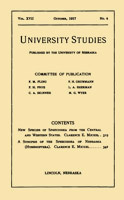University Studies of the University of Nebraska
Date of this Version
1-1917
Citation
UNIVERSITY STUDIES VOL. XVII, JANUARY 1917, No.1. 134 pp.
Abstract
Noone at all botanically inclined can travel through southeastern Washington without being impressed with the marked changes which a distance of only a few miles may show in the vegetation. Traveling eastward from a point fifty miles west of the Idaho state line, one passes from a region of scab-land sagebrush through one of rolling hills covered with bunch-grasses. Upon steadily ascending the great Columbia Plateau, the 'bunchgrasses give way to well developed prairies, and these in turn, near the Idaho line, to forests of yellow pine, Douglas fir, white fir, tamarack, and cedar. Or starting from Spokane in the central part of eastern Washington and traveling southward, one soon leaves the pine woodland of the Spokane gravels and passes again through the rolling prairies. Projecting above the surrounding sea of prairie-covered basalt are islands of quartzite, the tops of lofty mountains almost buried under the 'basalt. These may be covered with grass land on the windward side, while at a distance of a few meters over the crest the prairie may give way to rather dense forests. Cut through the layers of basalt, in a mighty canyon, 1,600 feet deep, the Snake River winds its way through the prairie 'belt. Upon descending into the canyon one finds the bunch-grasses and sagebrush vegetation growing in a climate markedly different from that of the plateau above. Far southward from the canyon of the Snake River rise the pine-covered foothills of the Blue Mountains.
Such is a brief glance at the wonderful field for investigation offered the ecologist in southeastern Washington. It is a field in which many stages in succession are offered within relatively easy reach of a base station and one in which the vegetation so clearly reveals adjustment to climatic and edaphic conditions that one could scarcely wish for a 'better place in which to measure the factors of the habitat and the vegetational responses. Moreover, in this great inland province, practically no botanical work except of a taxonomic character has been done (3, 9, 10, II). Because of the high fertility of the deep basaltic soils, the prairie region has largely been broken up for the growing of wheat. Indeed, only isolated tracts of the best developed prairies remain intact, while hundreds of acres of the drier bunch-grass lands have been broken up during the time of the progress of this work. It seemed unfortunate that a record of the rapidly disappearing vegetation of this interesting region had not been made. Accordingly, early in the spring of 1912, reconnaissance work was begun, with Pullman, Washington, as the 'base station. Ecological work was pursued vigorously in season and out (with the exception of the summer of 1912) until the fall of 1914.

